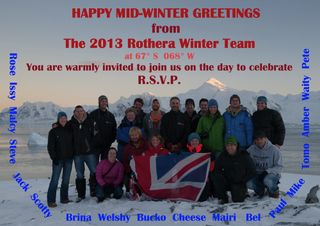Midwinter's Day Gets Big Bash in Antarctica

As the Northern Hemisphere enjoys the longest day of the year, the summer solstice, researchers overwintering in Antarctica are celebrating midwinter.
Midwinter's Day is the shortest, darkest day in Antarctica, but the staff at the four wintering research stations look forward to the solstice like Christmas — complete with homemade gifts.
"You can't go shop and buy anything, so you put in a lot of effort and time," said Andy Barker, who works at the air unit at the British Antarctic Survey headquarters in Cambridge and who has spent three winters in Antarctica.
Summer above, winter below
Summer in the Northern Hemisphere brings winter in the south because the Earth's axis is on a 23.5-degree tilt. This tilt points the Northern Hemisphere at the sun for longer in the summer, but the Southern Hemisphere spends its time tilted away from the sun, leading to shorter days and winter.
Antarctica is so far south that it bears the brunt of this tilt; during Antarctic winter, the sun doesn't peek above the horizon for months (some locations get a few hours of twilight per day). In the Antarctic summer, the Earth's tilt causes the opposite effect, bringing weeks without a sunset.
Most research activities in Antarctica occur during the continent's summer, when it's lighter and (relatively) warmer. But a handful of brave souls spend the winter keeping the continent's research stations running.
Sign up for the Live Science daily newsletter now
Get the world’s most fascinating discoveries delivered straight to your inbox.
"It's good fun," Barker told LiveScience. "Occasionally people don't get on, but generally everyone gets on and has a really good time." [Images: Life at an Antarctic Research Station]
Celebrating the darkest day
That's particularly true on Midwinter's Day, which traditionally starts with breakfast cooked by the research base commander — often bacon sandwiches or a traditional English breakfast, Barker said, though one year he made croissants.
In the afternoon, staff members gather to watch a film, typically one with an Antarctic theme. This year, the Rothera base, located on Adelaide Island, will be screening "The Thing" or "Anne," according to the midwinter program released by the British Antarctic Survey.
A festive meal rounds out Midwinter's Day, and the best provisions are always kept aside for the feast, Barker said. The menu for Rothera staff this year includes quesadillas, a caramelized onion and blue cheese tart, king prawn (shrimp, in American English) cocktails, mushroom and white truffle oil soup, and steak. For a sweet finish, staff can sample chocolate and ginger torte, espresso ice cream and Kahlua cocktails with mint chocolate truffles.
Staff members each give a gift to one other person, Secret Santa-style, and a lot of effort goes into making those gifts special, Barker said. People learn carpentry or other skills to perfect the presents, he said. In his winters, Barker made his gift recipients picture frames, a 52-week planner running from one Antarctic midwinter to the next, and a DVD of photos and videos taken over the previous eight months.
Winter staff members get recreation time outside of Midwinter's Day as well, Barker said, and they usually have about a day and a half off per week. They also have amenities such as a gym for workouts and a darkroom for old-fashioned photography. Nearby mountains allow for skiing and mountaineering, weather permitting.
"It's a fantastic experience," Barker said.
Follow Stephanie Pappas on Twitter and Google+. Follow us @livescience, Facebook & Google+. Original article on LiveScience.com.

Stephanie Pappas is a contributing writer for Live Science, covering topics ranging from geoscience to archaeology to the human brain and behavior. She was previously a senior writer for Live Science but is now a freelancer based in Denver, Colorado, and regularly contributes to Scientific American and The Monitor, the monthly magazine of the American Psychological Association. Stephanie received a bachelor's degree in psychology from the University of South Carolina and a graduate certificate in science communication from the University of California, Santa Cruz.